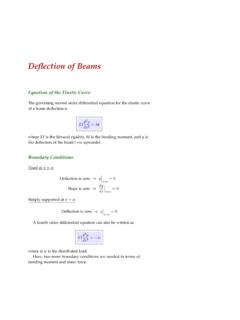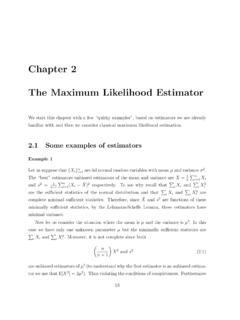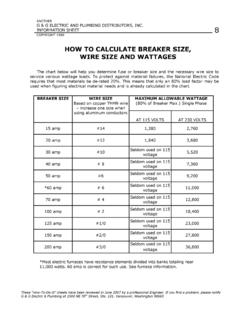Transcription of Shear Stress
1 Shear StressDue to the presence of the Shear force in beam and the fact thattxy=tyxa horizontal Shear force exists in the beam that tend to forcethe beam fibers to Shear in BeamsThe horizontal Shear per unit length is given byq=VQIwhereV=the Shear force at that section;Q=the first moment ofthe portion of the area (above the horizontal line where the Shear isbeing calculated) about the neutral axis; andI=moment of inertia ofthe cross-sectional area of the beam. The quantityqis also known astheshear Shear Stress Across the WidthAverage Shear Stress across the width is defined astave=VQItwheret=width of the section at that horizontal line.
2 For a narrowrectangular beam witht=b h/4, the Shear Stress varies across thewidth by less than80% Transverse Shear StressFor a narrow rectangular section we can work with the equationt=VQItto calculate Shear Stress at any vertical point in the crosssection. Hence, the Shear Stress at a distanceyfrom the neutral axisQ= b h2 y y+h/2 y2 =b2 h24 y2 A=bhI=112bh3txy=tyx=VQIb=V b2 h24 y2 112bh3 b=3V(h2 4y2)2bh3=3V2A 1 4y2h2 ORtxy=tyx=V2I h24 y2 - a parabolic distribution of , the maximum Stress in a rectangular beam section is aty=0 andtmax=3V2 AIn case of a wide flanged beam like the one shown here the maxi-mum Shear Stress is at the web and can be approximated astmax=VAwebProblem1.
3 (a) Using the wooden T section as shown below and used in theprevious classes find the maximum Shear it can take where the nailshave a capacity of800N against Shear loads and the spacing betweenthe nails the parallel axes theorem,I1=112bh3+Ad2=112 ( ) ( )3+( ) ( ) ( )2= 10 6m4I2=112bh3+Ad2=112 ( ) ( )3+( ) ( ) ( )2= 10 6m4 Scanned by CamScanner" 1" " - ""99 ' " & 9'@@ )) 2 1 4 29(9 " 29$ = 0 9 " "# 9 . " .Figure65: Problem1: , the moment of inertia of the T section about the centroidalaxisx0I=I1+I2= 10 6m4 Figure66: Problem1: spacing of first moment of the cross-sectional area isQ=A1 y1=( ) ( ) ( )=102 10 6m3 The nails haveFnail=400N.
4 Ifqallis the allowable Shear per unitlength andsis the spacing between the nails thenFnail=qalls)qall=Fnails= 103N/mHence,qall=VmaxQI)Vmax=qallIQ=(8 103N/m) ( 10 6m4)102 10 6m3= (b) IfV=1 kN and estimate the maximum Shear Shear Stress occurs at the neutral axistmax=VQIt=(1 103N) (119 10 6m3)( 10 6m4) ( )= (c) Instead of two wooden planks as shown before if four woodenplanks, two horizontal nails, and a single vertical nail are used asshown below. estimate the spacings required for the two horizontalnails forV=1kNandFnail= : Problem1: four planks this case, the Shear at the joint of1st and the2nd part needs tobe estimated.
5 For thisQ=A1 y1=( ) ( ) ( )=51 10 6m4 Now,Fnails=q=VQI=(1 103N) (51 10 6m3) 10 6m4= )s=Fnailq= , a spacing of100mm will be (a) For the box section shown here estimate the nail spacing requiredifV=1kNandFnail= : ( ) ( )3+( ) ( ) ( )2= 10 6m4I2=I3=112 ( ) ( )3= 10 6m4 The second moment of inertia of the cross-sectional area about theneutral axisI=I1+I2+I3+I4=2 10 6m4+2 10 6m4= 10 6m4 The first moment of the top part about the neutral axis isQ=A1 y1=( ) ( ) ( )=80 10 6m3 The Shear flow here2 Fnails=q=VQI=(1 103N) (80 10 6m3) 10 6m4)2 400Ns= )s= , a spacing of75mm will be okay.(b) calculate the maximum Shear Stress : the neutral axisQ=80 10 6m3+2 ( ) ( ) ( )=98 10 6m3 maximum Shear stresst=VQIt=(1 103N) (98 10 6m3)( 10 6m4) (2 )= : the beam as shown below forsall=80 MPaandtall=10 MPa.
6 The depth of the beam is limited to275mm. Use standardrolled steel Shear force and bending moment diagrams are drawn the diagrams,|V|max=20kNand|M|max= : Problem3: SFD, for bending stressHence, section modulus requiredSreqd=|M|maxsall=100 103Nm80 106Pa= 10 3m3=1250 103mm3 Since the depth is limited choose W250 80and add two8mmthick plates at the top and depth =273mm <275mm (okay).The modified I section has a second moment of inertia about theneutral axisI=Ibeam+2 Iplate=126 10 6m4+2 112 ( ) ( )3+( ) ( ) ( )2 = 10 6m4 Figure72: Problem3: Modified 10 6m3>SreqdCheck for Shear stressA(mm2) y(mm)A y(mm3)Plate1254 103I-section2254 103 Figure73: Problem3: Shear A y= 103mm3,t= , maximum Shear Stress istmax=|V|maxQIt=(20 103N) ( 10 6m3)( 10 6m4) ( )= <tall(okay)










